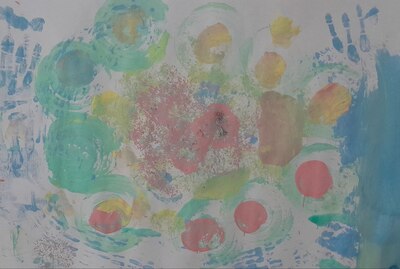
The language
The English language in this lesson was the absolute hero, leader, priority and star! We did a lot of practice with food, talking about food, discussing preferences and likes. We played with the flashcards, we made very simple riddles and we did the song (‘Do you like broccoli ice-cream?‘) and the broccoli ice-cream game (aka making up your own food combinations).
We also did the magic bag with all the vegetables later to be used in the creative part and this was yet another opportunity to drill the key words. These were not all the fruit and all the vegatables that I wanted the kids to learn. For this particular activity I chose the set that would help us get interesting patterns, even if they might not be the most necessary vegetables for the beginner students to learn, namely: corn, broccoli, onion, carrot, bell pepper and potatoe.
It is also worth adding that this particular lesson was followed up by one more creative activity, a lesson in which we made monster sandwiches which, actually, is also some kind of food art. This gave our day a lovely frame. You can read about the sandwiches here.
Unfortunately, this time, we did not have any artist of the day. Initially I planned to go for a ‘no-artist’ lesson and then when I remembered about Giuseppe Acrimboldo, it was already kind of too late. It would be lovely to show this way of using fruit and vegetables to create paintings and then to switch to a more direct and obvious vegetable art making…Nevermind, there is always going to a ‘next time’!
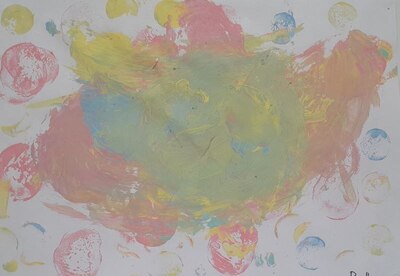
The art
As for the set-up, this was another lesson in which we used shared resources. I put a paper-covered table in the middle of the room and all the vegetables and all the paints would be there. The kids were directed to walk around the room, pick up the vegetables, collect some paint and move on to their tables to print.
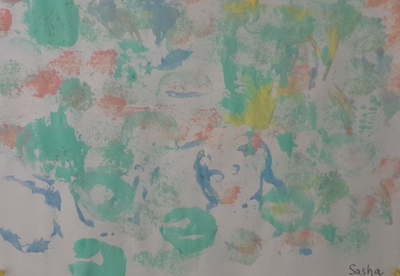
The artist
I was considering using different types of paints but decided to go for the fingerpaint. We have only four colours but it is easy to wash, it has the perfect texture and it dries fast.
All the pages were fastened to the kids’ tables with painter’s scotch to keep them from moving around. I have also noticed that it helps to prevent the paint from being all over the place. We still need to clean the tables, of course, but the immovable page keeps it down a bit.
I gathered all the children around the table in the middle of the room and I prepared the vegetables: I cut the potatoes into different pieces, halves and blocks, I cut the onion into halves and bell pepper into slices. We used the carrot and the corn as it was and kids came up with the idea of rolling even before I managed to to demonstrate anything myself. With the kids still around, I experimented with all the pieces, on my page, just to show the kids all the different patterns that can be created. Everyone got a few wet tisses and we started to work.
If I had to choose one word to describe this lesson, I would go for ‘discovery’ because that’s what we all did, discovering and finding out what could possible be achieved with the pieces of vegetables and paint, how you can print, roll, press, dab, drop and how different patterns work together with different colours or different prints.
On the day, I had a mixed ability group, a four-year-old, an eight-year-old and everyone in-between, some ‘advanced’ English speakers and some beginners. Linguistically, we had different aims for all of the kids. I was hoping that for my beginners it will be an opportunity to use the words once more. With my older and more advanced kids, we just chatted about the creative process.
Artistically, everyone created what they wanted. Some of the paintings are more advanced and show imagination put to good use (this from my youngest student!), some are a result of a more careful experimentation with different patterns and prints. I am happy to say that all the kids were involved and they loved exploring the new resource. Throughout the lesson I could hear the surprised and joyful ‘Oh, look’ from different corners of the classroom. And, then, looking at all the photos we took in class is a different kind of a pleasure and they can be divided into two different types: type A: kids being beyond focused and concentrated on the process and type B: kids being in awe at the outcome.
The one issue that we had (as usual, if I may) were the repeated questions from the students. The first one was ‘Are they real vegetables?‘ and the other, immediately right afterwards, ‘Can we eat it?’ To be honest, it does not cease to surprise me that, again and again, I have to deal with that. I would have thought that raw veggies, usually eaten boiled or baked, will be so exciting and tempting but they still are! Despite the fact that I keep repeating my mantra ‘These are materials. We don’t eat materials’…
On the day, I was actually beyond happy that I had my third lesson in store (Monster Sandwiches) and that I could promise that, yes, there is a surprise and yes, we are going to eat something eventually. It might be something to consider while planning a lesson with food. It would be good to have something to snack on in the end…
I also wanted to mention three sources that inspired this lesson. Two were articles from my fellow bloggers. Here they are: food painting from Parents Club and harvest food painting from New Horizon Academy. There was also a video (which I cannot find now) about painting with nature whose author did a lovely picture with leaves and sticks and who, used only the fallen leaves and sticks, not to destroy any living plants, and who, at the end, washed everything and took things back to the garden.
This brings me to another point that I wanted to make here. I had real doubts about using real fruit and vegetables in such an activity because I didn’t want to promote the idea of wasting food. Something that my students also brought up. For that reason, I chose the oldest vegetables in the supermarket, all the almost dead potatoes, carrots and corn and to cut down on waste, we only had one of each that the children were sharing. This is definitely something to consider while planning a lesson like that.
Now, welcome to Our Gallery!
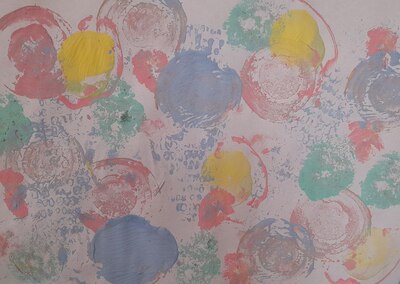
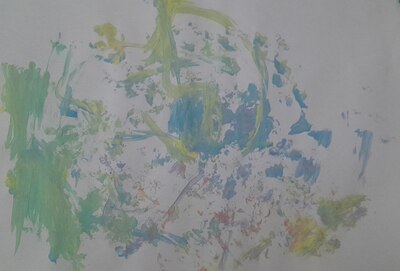
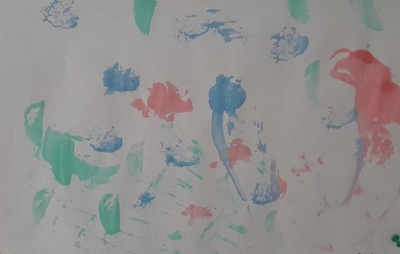
Happy teaching!